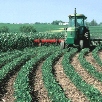
ASSE Offers Tips to Reverse Upward Spiral in Farming Fatalities
With the growing season in full swing and the recent release of fatal work injury statistics showing an upward spiral in the farming industry, the American Society of Safety Engineers encourages SH&E professionals to become active in assisting agricultural producers and businesses in their area to take steps to prevent deadly agricultural injuries and illnesses, offering a number of tips for the industry, some of which are aimed specifically at protecting young farmers, who face a greater risk of being injured.
According to the U.S. Bureau of Labor Statistics, workplace fatalities in the farming industry rose by 11 percent in 2008 to a total of 651 deaths in the agriculture, forestry, fishing, and hunting industries in the United States. The increase was led by worker deaths in crop production, which rose 18 percent in 2008. Most farm-related traumatic injuries are caused by machinery, with tractor accidents next--accounting for a high rate of fatalities. According to NIOSH, from 1992 to 2007 more than 8,000 farm workers died from work-related injuries in the United States, with tractor overturn deaths accounting for an average of 96 deaths annually.
In addition, about 243 agricultural workers suffer lost-work-time injuries every day, and about five percent of these injuries result in permanent impairment, making the industry one of the most dangerous for young workers and one of the few industries where families are at risk of fatalities or injuries as they often share the work and live on the farm, ASSE notes.
As most farms do not fall under the auspices of OSHA rules and regulations, ASSE urges farmers to train all workers including young farmers well in all aspects of farming, including safety. Children are at special risk from farm-related accidents. Most of the 100-plus deaths among children on farms result from being innocent bystanders or passengers on farm equipment. Surveys indicate that many farm children are working in dangerous environments by the age of 10, ASSE says. Young farmers can enroll in a local farm safety camp, often sponsored by the local county extension service, a university, or farm bureau, which helps them recognize and learn how to address on-the-job hazards.
ASSE established a new Agricultural Branch as part of the society's Environmental Practice Specialty. In addition to providing a forum for SH&E professionals in the agricultural industry aimed at discussing risks and addressing solutions in this industry, the branch is designed to provide a venue to network and gain knowledge regarding best practices in safety and health issues affecting agricultural production operations of all sizes, including seed production, agricultural chemicals, transportation, equipment safety, compliance and enforcement.
"Too many farm family members and hired workers are getting hurt and dying on farms," said ASSE Director of Member/Region Affairs and agricultural safety specialist Terry Wilkinson, Ph.D., CSP, CAE. "Following simple farm safety tips to protect farm family members and children as well as hired workers on farms can prevent many farm-related injuries and illnesses, and enhance safety. A combined effort by the safety professionals and agricultural community can lead the industry into a new direction to prevent future traumatic injuries and illnesses."
ASSE offers these safety tips:
- Develop an awareness of hazards on the farm and prepare for emergency situations including machinery entanglements, fires, vehicle collisions, electrical shocks from equipment, and adverse health effects from chemical exposures.
- Reduce the risk of injury and illness with preventive measures. Read and follow instructions in equipment operator's manuals. Follow instructions on product labels for safe use, handling, and storage.
- Conduct routine inspections of your equipment to determine problems and potential failures that may contribute to or cause an injury. Properly maintain tools, buildings, and equipment.
- Conduct meetings with employees and family members to assess safety hazards, discuss potential accident situations, and outline emergency procedures.
- Provide approved rollover protective structures (ROPS), which are compartment structures (usually cabs or frames) intended to protect equipment operators from injuries caused by vehicle overturns. Use seat belts while the tractor is in operation on tractors equipped with a ROPS.
- Make sure guards for farm equipment are put back on after maintenance to protect workers from moving machinery parts. Also, keep all equipment at least 20 feet from any overhead power lines or wires that support poles.
- Review material safety data sheets and labels that come with all chemical products.
- Communicate information concerning hazards to all workers. Prevent pesticide poisonings and dermatitis caused by chemicals by ensuring that protective measures recommended on the labels are taken.
- Take the necessary precautions to prevent entrapment and suffocation caused by unstable surfaces of grain storage bins, silos, wagons and other storage structures.
- Be aware that methane gas, carbon dioxide, ammonia, and hydrogen sulfide can be present in manure pits in quantities sufficient to cause asphyxiation or explosion.
- Farmers are at great risk of contracting respiratory problems due to the amount of dust and chemicals they breathe in on a daily basis. Wearing protective equipment, which is readily available, can prevent acute and chronic respiratory illnesses. Protective equipment such as mechanical filters and chemical cartridge masks are air-purifying respirators that help protect lungs from harmful gases and dusts.
- Seek out local resources from ASSE chapters, county extension offices, farm bureau, and health facilities focusing on the agricultural community.
For more information about agricultural safety and health and to view the downloadable ASSE farm safety facts for rural areas, farm safety and health tips, and farm safety tips for young workers, visit www.asse.org/newsroom.